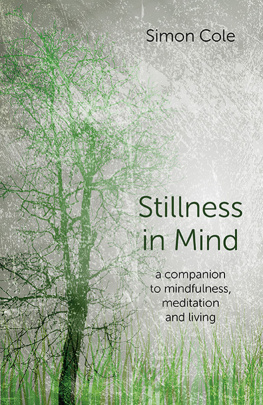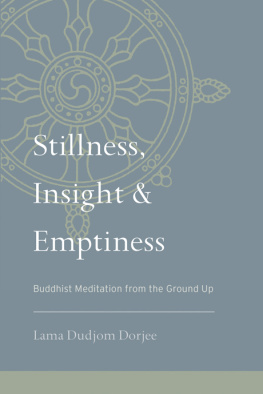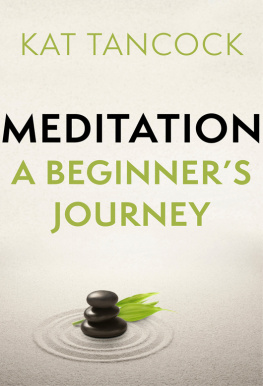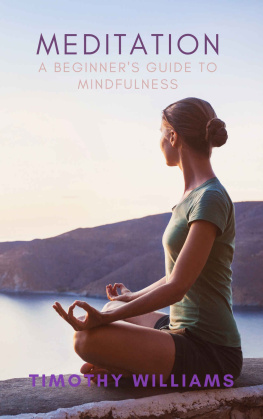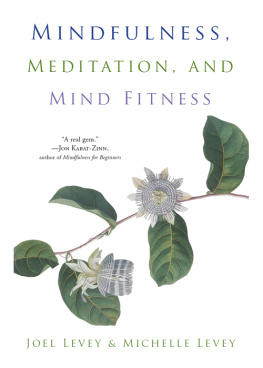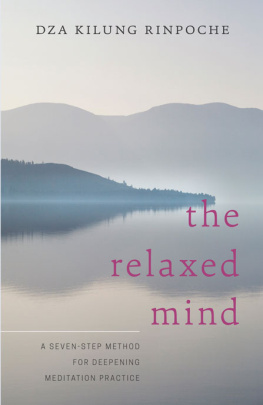WHAT PEOPLE ARE SAYING ABOUT
STILLNESS IN MIND
Simon Cole is a counsellor, therapist and meditation teacher with deep understanding of his subject.
He takes you on a journey to explain clearly the various levels of meditation and how it can heal the stressed and busy mind to move you into a much greater self-understanding finding that wonderfully peaceful and joyful clear space within.
A must read for all that are interested in meditation.
Stafford Whiteaker in The Good Retreat Guide 2014, author of Good Living in Hard Times: the Art of Contentment (O-Books), Living the Sacred - Ten Gateways to Open your Heart (Rider & Co), and The Little Book of Inner Space (Rider & Co)
I really enjoyed reading this book; it was refreshing to read about mindfulness and meditation from a Person-Centred/Counselling perspective I found the descriptions and meditations accessible and informative and the idea of linking breathing meditations with different mind states was useful, reminding me of yoga pranayama the description of self-actualisation was a breath of fresh air and clearer than other ideas about development I have come across in meditation and psychotherapy the story of the Buddha listening to the wind was thought provoking, leading the reader to ponder a little more and in an unhurried way.
I would highly recommend the book to both introductory and more advanced mindfulness practitioners.
Simon Carver MA, PMBACP, accredited counsellor and psychotherapist
First published by Changemakers Books, 2014
Changemakers Books is an imprint of John Hunt Publishing Ltd., Laurel House, Station Approach,
Alresford, Hants, SO24 9JH, UK
www.johnhuntpublishing.com
www.changemakers-books.com
For distributor details and how to order please visit the Ordering section on our website.
Text copyright: Simon Cole 2013
ISBN: 978 1 78279 739 5
All rights reserved. Except for brief quotations in critical articles or reviews, no part of this book may be reproduced in any manner without prior written permission from the publishers.
The rights of Simon Cole as author have been asserted in accordance with the Copyright, Designs and Patents Act 1988.
A CIP catalogue record for this book is available from the British Library.
Design: Lee Nash
Printed and bound by CPI Group (UK) Ltd, Croydon, CR0 4YY
We operate a distinctive and ethical publishing philosophy in all areas of our business, from our global network of authors to production and worldwide distribution.
CONTENTS
not being distracted;eating into mindfulness
not judging not censoring
five precepts; mindfulness as the channel; thoughts, thinking and the sense of a thing
posture and sitting; contemplation after meditation; distractions; difficulty with motivation
mindfulness of feelings
attachment, disappointment, sadness, regret, remorse, guilt, jealousy, anger, anxiety, stress; meditation and pain
empathy; the process of being with
just being; the sense of me and
For my family
Acknowledgements
This book draws on many years of working with people who were distressed and who have touched my life and I theirs. I have been affected, as they have, by our contact. So first I must acknowledge those (whose names I could not mention even if they were all still with me) clients, students, voices, companions, fellow travellers, all of them part of the story.
In the introduction I mention the three intellectual giants behind my own philosophy and approach: Martin Buber, Carl Rogers and Eugene Gendlin. There have, of course, been many others, but for me these were cornerstones.
More specifically, and in relation to various versions of this book itself, I am indebted to my wife Janet, for an outsider view at many points and to Diana Armstrong and Simon Carver, as established and successful therapists, for their time in reading and commenting cogently on more or less complete manuscripts, though errors and omissions are of course my own.
Finally I must thank the owner of the material who gave permission for its use as the example in the chapter Clear Space and whom I am unable to name.
Introduction
This work started out as a handout to follow my retreat courses in mindfulness meditation. Working from a centre to which people come for individual or group retreat, where they may stay from a few days to a few weeks, I have often felt, on the one hand, that I was never able to go far enough to set people off on the path of valuing a day-by-day meditation practice, while, on the other hand, I was conscious that I was rushing in giving extra steps in order to better prepare them to continue when they left. I was also aware, particularly with our client-guests who came on individual retreat, that the before and after of the meditation sittings drew strongly on my background as a counsellor and psychological therapist. As a result, my idea of what I was writing started to evolve: the handout was starting to grow into a handbook, and then it felt as if it could be, not so much a manual of techniques, but a companion for a way of living.
What I would like you to find here, at the outset, is an everyday approach to a practice which is too fast becoming intellectualised on one level and trivialised by phone apps and the like on another namely mindfulness and then an invitation to move on from mindfulness into meditation, using a path which adopts a western therapeutic approach, in order to hold the link with day to day living. You will find chapters introducing mindfulness, and then the Clear Space Meditation Path and, because there is the opportunity to use this meditation path for personal growth or as an intentional therapeutic activity, I look at how we experience common emotional difficulties, relating them to this practice of meditation. After that I develop further the themes of mindfulness (particularly as an everyday intervention) and meditation, to bring in the new philosophy of living, which I believe can start to evolve.
The framework is that of a handbook, rather than a course or a technical treatise. However, for anyone wanting something more like a course, there are pointers to using it that way. It is difficult, when writing something like this, to pitch explanations at a level which would suit all possible readers. If, therefore, I have erred on the side of too much explanation of some terms for some readers, then I apologise; it was done in the interests of being as inclusive as possible.
I like to express things, as far as possible, in everyday language. For this reason you will not find any reference to Pali terms and only general references to Buddhism and its associated psychology. I acknowledge the deep connection between meditation and Buddhism, but I do not see it as a necessity to understand its processes and psychology in those terms. The practice of meditation can sit alongside a western philosophy of life and living and be expressed in such terms without losing anything of its spiritual nature and meaning. It can also be an accompaniment to psychological therapy of any kind. It does not cut across any precepts or practices of therapy; rather it loosens up our awareness at an emotional level and can often provide data in the form of insights or glimpses of enlightenment which can be worked with in a therapy session. So, if you come to this while you are engaged in counselling or similar, I would encourage you to welcome it and include it alongside the work you are already doing.

